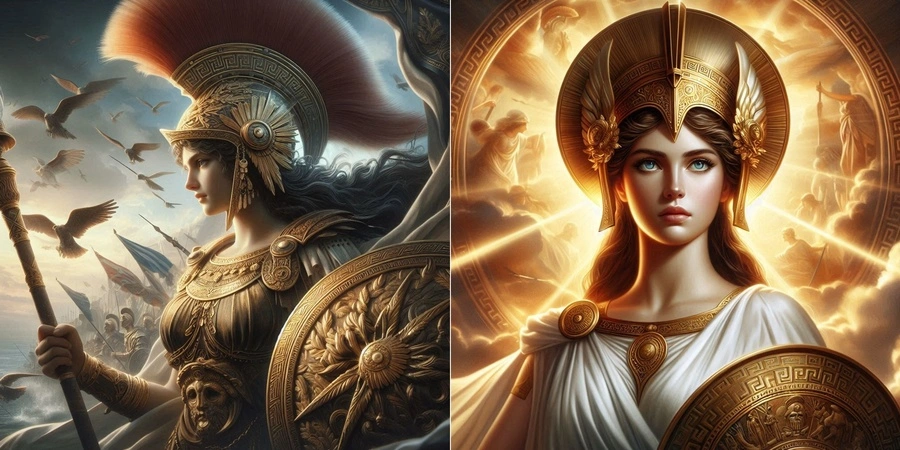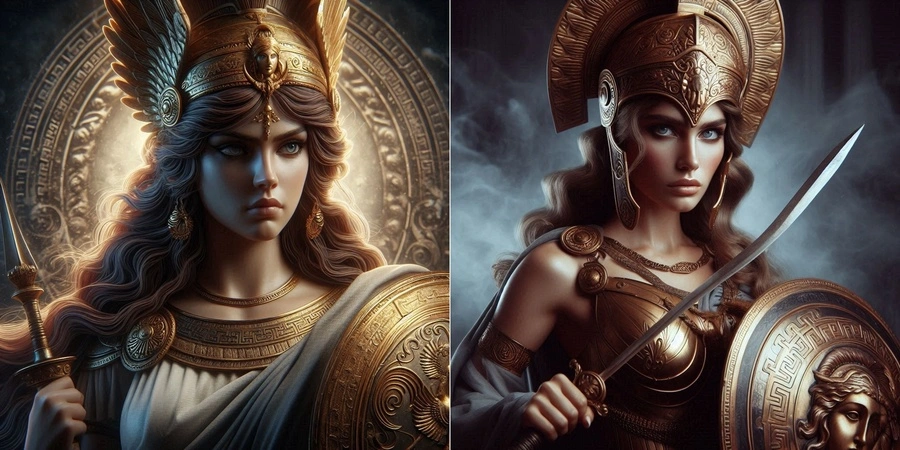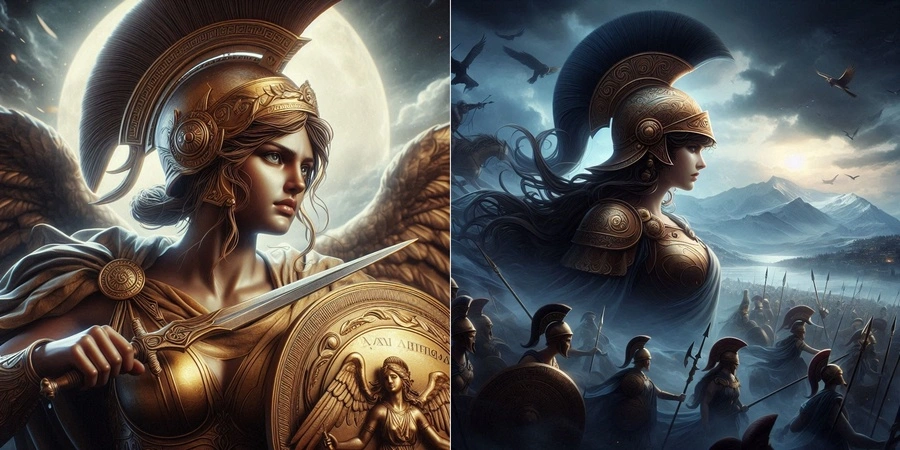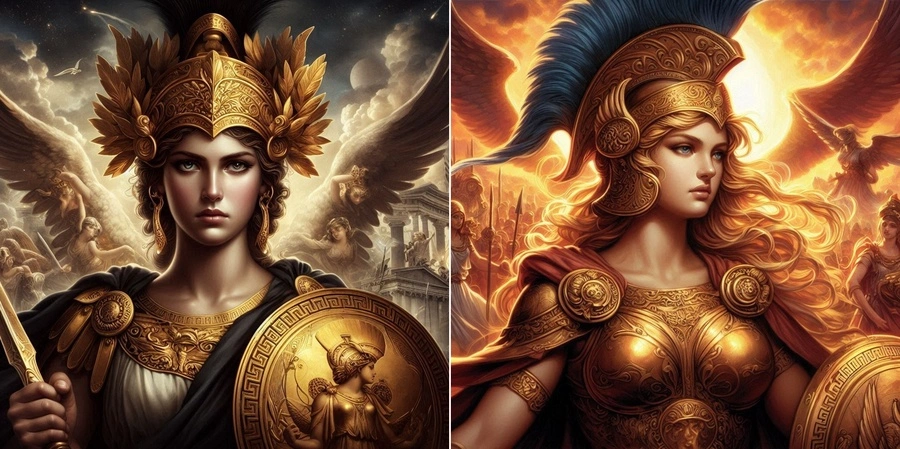
In Greek mythology, Athena is a powerful and prominent goddess, known as the goddess of wisdom, courage, and warfare. She is often depicted as a fierce warrior, donning a helmet and carrying a spear and shield, but she is also associated with more peaceful pursuits such as the arts, crafts, and weaving.
Athena was the daughter of Zeus and Metis, but she had no brothers or sisters. Instead, she was often depicted as a virgin goddess, with no children or romantic interests. However, she did have a close relationship with her half-brother, Apollo, the god of music and prophecy.
Athena is one of the twelve Olympian gods and goddesses, and she was highly revered in ancient Greece. She was often worshiped as the patron goddess of cities, especially Athens, which was named in her honor. As the goddess of wisdom, she was seen as a protector of learning, and many ancient Greeks believed that she inspired great works of art, literature, and philosophy.
Story of Athena
Athena’s birth story is as unusual as the goddess herself. Fearing a prophecy that his child would overthrow him, Zeus, the king of the gods, swallowed Metis, the goddess of wisdom, whole. However, Metis was already pregnant with Athena. From within Zeus’s head, Athena emerged fully grown, clad in armor and wielding a mighty spear. This dramatic birth foreshadows Athena’s character – a powerful mind housed within a formidable warrior.
Athena’s association with wisdom goes beyond mere intellect. She is the embodiment of practical knowledge, strategic thinking, and cunning. Heroes like Odysseus, known for his wit and resourcefulness, enjoyed Athena’s favor. She was also the patron of artisans, especially weavers. The intricate tapestries adorning Olympian halls were likely attributed to her skills. This connection between wisdom and craft highlights the importance of applying knowledge to create something tangible and beautiful.

While Ares revels in the bloody chaos of battle, Athena represents the more strategic and defensive aspects of war. She is a protector of cities and the champion of just causes. In the Trojan War, she aids the Greeks, not out of bloodlust, but to defend their stolen honor. Her guidance emphasizes cunning strategies, defensive maneuvers, and the importance of protecting one’s homeland.
There’s also a strong emphasis on justice in Athena’s portrayal of war. Take the story of Medusa, a once-beautiful Gorgon who was cursed with a monstrous visage. When a drunken Polyphemus boasted of assaulting Athena’s temple, Medusa became the target of her wrath. While Athena’s punishment seems harsh, it highlights the consequences of violating sacred spaces and the importance of upholding order.
In Roman mythology, Athena was equated with the goddess Minerva. The Romans adopted many aspects of Athena’s worship and attributes, emphasizing her roles as a goddess of wisdom, strategy, and the arts. Minerva continued to be revered throughout the Roman Empire, reflecting Athena’s enduring influence beyond Greek borders.
10 Myths and Facts about Athena
1. The Weaving Contest and the Birth of Arachne’s Hubris: While Athena is the patron of handicraft, particularly weaving, a myth tells the tale of a talented mortal weaver named Arachne. Arachne, known for her exquisite tapestries, dared to challenge Athena to a weaving duel. Athena’s tapestry depicted the orderly lives of the gods, while Arachne’s boastfully showcased the amorous exploits of Zeus and other deities. Though Arachne’s skill was undeniable, Athena, enraged by the weaver’s arrogance, cursed Arachne, transforming her into a spider forever doomed to spin webs.
2. The Naming of Athens and the Gift of the Olive Tree: According to a popular myth, Athena and Poseidon, the god of the sea, competed for the patronage of a newly founded city. Poseidon struck the ground with his trident, causing a magnificent spring to erupt. Athena, however, countered with a gift far more beneficial – an olive tree, symbolizing peace, prosperity, and valuable olive oil. The citizens, recognizing the long-term value of Athena’s offering, named the city Athens in her honor.
3. The Cunning Deception: Athena and the Daughters of Cecrops: Cecrops, the mythical first king of Athens, had three daughters devoted to Athena. The goddess gifted them with a chest, warning them never to peek inside. Two sisters, unable to resist their curiosity, opened the chest, revealing a baby Erichthonios, a serpent-tailed creature. Driven mad by the sight, they flung themselves from the Acropolis. Athena, saddened but resolute, raised Erichthonios and became his protector, ensuring the continuation of Cecrops’ lineage.
4. The Shield of Protection: The Aegis and the Head of Medusa: One of Athena’s most recognizable symbols is the Aegis, a shimmering goatskin shield fringed with writhing snakes. In the center lies the severed head of Medusa, a monstrous Gorgon slain by the goddess. However, the head wasn’t just a gruesome trophy. Medusa’s gaze had the power to turn men to stone. By incorporating it into her Aegis, Athena not only wielded a powerful shield but also used the Gorgon’s power to petrify her enemies.
5. The Birth of Music and the Unlikely Rivalry: A lesser-known myth tells the story of Athena and Marsyas, a satyr known for his exceptional music skills. Marsyas, playing the aulos (a double-piped wind instrument), challenged Athena to a musical duel. Athena, a talented musician herself, accepted. However, when Marsyas attempted to play her flute, an instrument requiring control over both breath and hand movements, he failed miserably. Humiliated, Marsyas begged for mercy, but Athena, angered by his arrogance, flayed him alive. From his spilled blood, the first notes of mournful music arose, forever linking Marsyas to the art form.
6. Protector of Heroes: Athena’s Role in the Labors of Heracles: Heracles, the mighty demigod son of Zeus, undertook twelve seemingly impossible tasks known as the Labors of Heracles. Athena, recognizing his potential and righteous nature, became his patron and guide. She gifted him with a bronze helmet and a golden breastplate, offering him protection throughout his heroic endeavors. During the second Labor, where Heracles had to retrieve the golden apples of the Hesperides, Athena provided him with crucial advice on how to outwit Atlas, the Titan who guarded the tree.
7. The Judgement of Paris and the Trojan War’s Catalyst: Paris, a Trojan prince, was tasked with judging the beauty of three goddesses – Hera, Athena, and Aphrodite. Each goddess offered him a bribe – Hera, power; Athena, military victory; and Aphrodite, the love of the most beautiful woman in the world. Paris, swayed by Aphrodite’s offer, chose her. This enraged Hera and Athena, who sided with the Greeks in the Trojan War, ensuring a conflict fueled by divine intervention.
8. The Forgotten Suitors and the Weaving of a Web of Deception: While Odysseus, king of Ithaca, was away fighting in the Trojan War, his wife Penelope was besieged by suitors vying for her hand and his throne. Penelope, determined to remain loyal to her husband, devised a cunning plan with Athena’s guidance. She declared she would choose a new suitor only after weaving a magnificent burial shroud for her aging father-in-law. However, each night, she would secretly undo what she had woven the day before, effectively stalling the suitors and giving Odysseus time to return. This act of both skill and deception exemplifies Athena’s multifaceted nature.
9. The Birth of Democracy and the Council of the Areopagus: After the slaying of a relative, Orestes, son of Agamemnon, faced trial for his crime. The Athenians, torn between upholding tradition and respecting justice, established a new council – the Areopagus – to decide Orestes’ fate. Athena, known for her wisdom and fairness, presided over the council. The vote was split, and Athena cast the deciding ballot in Orestes’ favor, setting a precedent for a democratic system based on debate and citizen participation.
10. The Statue of Athena Parthenos and the Everlasting Symbol: Phidias, a renowned sculptor of ancient Greece, was entrusted with creating a monumental statue to honor Athena as the patron goddess of Athens. The resulting statue, the Athena Parthenos, stood over 34 feet tall and was made of gold and ivory. The goddess, depicted in full battle regalia, held a Nike (victory) statue in one hand and a shield adorned with scenes from Greek mythology in the other. Though the statue itself no longer exists, it remains a powerful symbol of Athena’s enduring legacy as a protector, warrior, and embodiment of wisdom.

The Symbols of Athena
The Aegis
Athena’s most iconic symbol is the Aegis, a shimmering shield crafted from the hide of a mythical goat, often depicted as fringed with writhing snakes. In the center lies the severed head of Medusa, a monstrous Gorgon slain by Athena herself. The Aegis wasn’t just a defensive tool – it was a potent weapon. Medusa’s gaze held the power to turn men to stone. By incorporating the Gorgon’s head, Athena not only wielded a formidable shield but also channeled the fearsome power of her vanquished foe, striking terror into the hearts of her enemies.
The Owl
The wise owl is another prominent symbol associated with Athena. Owls, with their keen eyesight and ability to navigate the darkness, represented vigilance, sharp observation, and the pursuit of knowledge even in the absence of light. These qualities perfectly mirrored Athena’s own – her strategic mind, her ability to see through deception, and her guidance offered even in the most challenging situations. The owl became not just her companion but also a symbol adopted by her city, Athens, signifying the city’s commitment to learning and intellectual pursuits.
The Olive Branch
While often depicted in armor, Athena also holds a powerful symbol of peace – the olive branch. The story of Athena’s gift to the newly founded city of Athens exemplifies this duality. Competing with Poseidon for the city’s patronage, Athena offered an olive tree, symbolizing peace, prosperity, and the valuable olive oil that would sustain the city. This act established her not just as a protector but also as a promoter of flourishing civilizations and a champion of peaceful pursuits.
The Helmet
Always portrayed clad in full battle regalia, Athena’s helmet is another significant symbol. Helmets, primarily used for protection in combat, represent Athena’s role as a fierce warrior and defender of just causes. But beyond mere physical protection, the helmet can also be seen as a symbol of strategic thinking. A well-formulated plan is like a mental armor, shielding one from impulsive actions and ensuring a well-thought-out approach to conflict.
The Snake
Snakes, often depicted writhing around the Aegis or adorning Athena’s statues, hold a complex symbolic meaning. In some myths, snakes represent cunning and deception, traits Athena employs strategically when necessary. In other contexts, snakes symbolize renewal and rebirth, reflecting Athena’s role as a protector and patron of cities, ensuring their continued growth and flourishing.
The Loom and Weaving
Athena, surprisingly, is also the patron goddess of weavers and handicraft, particularly weaving. On the surface, this might seem incongruous with her warrior image. However, weaving intricate tapestries requires meticulous planning, strategic placement of threads, and the ability to visualize the final product. These skills mirror the strategic planning and foresight Athena embodies as a warrior goddess. In this way, the loom becomes a symbol of the intellectual prowess required not just for crafting beautiful objects, but also for crafting successful strategies.

Frequently Asked Questions
What does Athena look like?
Athena is typically described as a striking figure of divine beauty and grace. She is often depicted as a tall and majestic goddess, with a solemn and thoughtful expression that reflects her wisdom and intelligence. Athena’s eyes are often portrayed as penetrating and wise, symbolizing her keen perception and insight into mortal affairs.
Artistically, Athena is depicted wearing a full suit of armor, including a helmet adorned with a crest, which signifies her role as a warrior goddess. Her armor is sometimes embellished with intricate designs and patterns, showcasing her status and authority among the Olympian gods. In addition to her armor, Athena is often depicted carrying a shield, spear, or both, emphasizing her prowess in battle and her role as a protector of cities and heroes.
Athena’s attire in classical Greek art and sculpture also includes a flowing garment, such as a chiton or peplos, which is worn under her armor. This garment adds a touch of grace and elegance to her formidable appearance, balancing her role as a warrior with her wisdom and nurturing qualities.
Physically, Athena is portrayed as youthful yet mature, embodying the idealized beauty of Greek goddesses. Her features are often described as harmonious and symmetrical, reflecting the artistic ideals of ancient Greek sculpture and painting. Athena’s hair is typically depicted as flowing and either loose or partially restrained, adding to her regal and commanding presence.
What powers does Athena have?
- Immortality and Superhuman Strength: As an Olympian god, Athena is immortal and possesses superhuman strength, speed, and endurance. She can withstand injuries that would be fatal to mortals and can fight alongside the mightiest warriors.
- Exceptional Wisdom and Strategic Thinking: Athena’s most renowned power is her unmatched wisdom. She is a master strategist, capable of formulating brilliant plans and outwitting even the most cunning opponents. Heroes like Odysseus sought her guidance for their successful endeavors.
- Shape-Shifting: While not as prominent as her other powers, Athena has the ability to change her form at will. This allows her to adapt to different situations and interact with mortals more easily.
- Gifting and Cursing: Athena can bestow powerful gifts upon those who earn her favor, such as knowledge, skill in battle, or specific objects imbued with magic. Conversely, she can also unleash devastating curses upon those who anger her.
- Aegis and the Power of Medusa: Her iconic shield, the Aegis, crafted from the hide of a mythical goat and adorned with the head of the slain Gorgon Medusa, serves as a powerful defensive tool. Anyone who gazes upon Medusa’s head is turned to stone, giving Athena a formidable advantage in combat.
| Athena, the Greek goddess of wisdom and war, occupies a unique place in the pantheon of ancient deities. Her blend of intellect, strength, and strategic acumen distinguishes her from other gods and goddesses, making her a symbol of rational thought, disciplined warfare, and cultural enlightenment. |